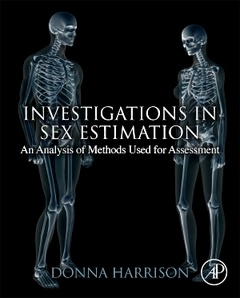Investigations in Sex Estimation An Analysis of Methods Used for Assessment
Auteur : Harrison Donna L.

- Provides the anthropological community with the results of the first collective comparison of the many morphological and metric methods currently used on adults and juveniles
- Introduces methods, reviews sexual dimorphism, and shares new insights for future research
- Highly illustrated, using testing data from four very diverse skeletal collections
Date de parution : 10-2018
Ouvrage de 448 p.
19x23.3 cm
Thèmes d’Investigations in Sex Estimation :
Mots-clés :
Adult measurements used on juveniles; African-American Great Migration; African-American data comparison; Age boundaries; Age boundary; Age boundary analysis; Archeological significance; Archetypical examples (photographs); Archetypical examples (photos); Best methods graphs; Bipedalism; Bone comparison; Culture; Ethnicity; Evolution; Future research; Gender; Genetic/occupational discussion; Grading systems; Grading systems analysis; Growth studies; Hamann-Todd Osteological Collection; Humeral epicondylar breadth; Humeral head diameter; Humeral septal aperture; Implications; Interobserver error; Intraobserver error; Juvenile; Limitations; Literature comparison; Locomotion; Lucy; Luis Lopes Skeletal Collection; Malocclusion; Mentum; Method comparison; Method reliability tables; Methods; Metric methods; Morphological methods; Neanderthal chignon; Parturition; Postnatal; Prenatal; Results; Sample size comparison; Sex estimation; Spitalfields Coffin Plate Collection; Summary; Terry Collection; Variation
